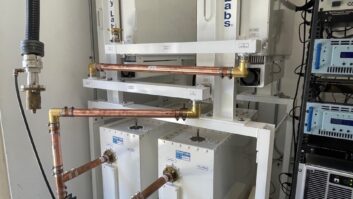One of the five leading causes of tower failure is anchor failure, says David Davies. He is a veteran of the tower industry and author of several industry-related papers and the Electrical Grounding and Corrosion chapter of the TIA/EIA code. Davies is working with Ernie Jones, founder of Consolidated Engineering Inc., a structural consulting firm specializing in broadcast towers.

David Davies
It is easy to forget about what is buried underground. But anchor failure is responsible for 10 percent of broadcast tower failures. The percentage is even higher in the cellular industry. Recent years have seen an increase in failures due to anchor steel corrosion.
Davies has developed a method for evaluating corrosion risk that the industry has not employed previously. He’ll discuss it during the upcoming NAB Show.
Corrosion Risk Assessment
Broadcasters are relatively unfamiliar with steel anchor corrosion and subsequent failure. Hoping to increase awareness, Davies says broadcasters should become more educated about the corrosion process.
“Half of tower owners have maybe only seen their tower but a couple of times, and don’t consider the parts the tower they can’t see, the ones that are underground,” he told Radio World. “So for them to be aware of the problem (corrosion of anchors) is the first step to prevention.”
For Davies, the process of making anchor inspections more accessible and cost-effective started four years ago, working with Scott Kisting of Midwest Underground Technology Inc., or MUTI.
Davies integrated non-invasive ultrasound testing, when applicable, to evaluate buried anchor shafts. This method avoids or limits the number of anchor shafts that required excavation to determine steel loss. About two years into the collaboration, he said, CEI and MUTI sensed a need for an accurate, cost-effective approach of evaluating and categorizing individual tower sites more efficiently, enabling a customer to prioritize and allot their maintenance budget in a more focused manner.
After implementing such a method, some 50 sites were excavated and contrasted against the findings of the Corrosion Risk Assessments, confirming the accuracy of this process.

The CRA provides a Risk Index based on several factors, ranking each site on a scale from 1–10. For each increment and circumstance, one or more actions are recommended.
“The key to accuracy is proper weighing and grading,” Davies said. “I call it vertical and horizontal integration. It tells you if you have a problem and how urgently you need to act.”
The process involves a mathematical algorithm based on a number of risk factors available for each site: soil type and characteristics, including moisture content and chemical properties, pH and Electrical Conductivity (EC). The age and geometric shape of the anchor are also variables, as is the presence of concrete encasement. The presence of stray electrical current is also included in the equation.
“We determine the presence of stray current emanating from pipelines and certain types of industry, all of which may be in close proximity to the site.” Agricultural influences may alter site soil characteristics. The information contained in the Corrosion Risk Assessment provides insight as to the health of a tower’s anchors, resulting in peace of mind, or the ability to take a proactive approach to protect their investment.
“There is no reason to lose sleep over something that is not a problem, though sleeping through a problem is foolish. The CRA lets them know how well they should sleep.”
Abatement

Tower failure caused by anchor rod corrosion.
“We recently concluded a study in the Midwest in which 89 sites were investigated,” Davies said. “Approximately 60 percent of these sites were either highly or moderately corrosive. I would guess approximate 20 percent were highly corrosive, with a recommendation for immediate action.”
He noted that these percentages may be a function of geography and should not be applied on a national basis.
Corrosion is typically found in areas where the soil tends to be clay-like. Dry, sandy soils usually present a lower risk. But again, these are very generalized statements.
Davies also will present various prevention/abatement and inspection methods that can be used in conjunction with a CRA. Even a low ranking on the CRA Risk Index scale will generate steps recommended to abate corrosion.
Installing a passive sacrificial anode seems to be the universal fix. “Anodes don’t repair what’s already corroded, but help prevent future damage. For around $500 an anchor, anodes are more cost-effective than the other choices, which are coatings and concrete encasement.”
For tower owners and stakeholders, Davies encourages site education and taking time to research site conditions.In using the CRA model, he feels, catastrophic failure of tower anchors will be largely avoided. He believes it is a simple and cost-effective tool that gives a clearer view of what may be occurring underground and out of sight.
The presentation “Preventing the Next Tower Disaster” is part of the Broadcast Engineering Conference session on “Disaster Preparedness and Recovery,” scheduled for Wednesday of the NAB Show.












